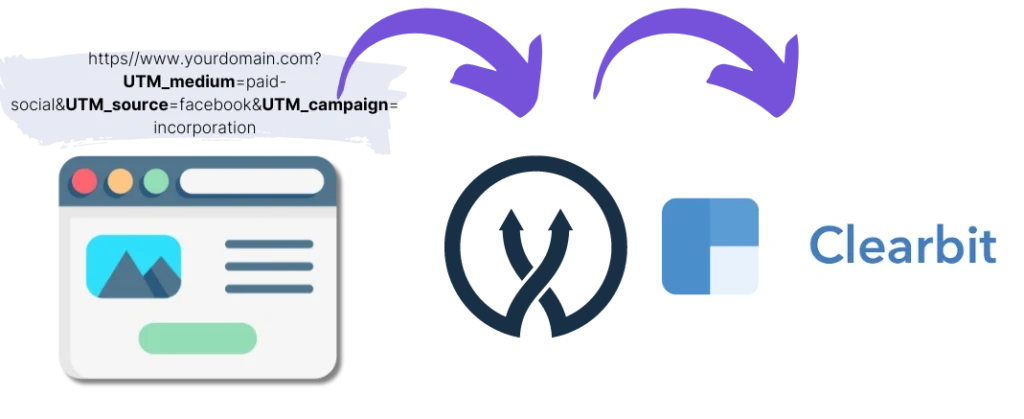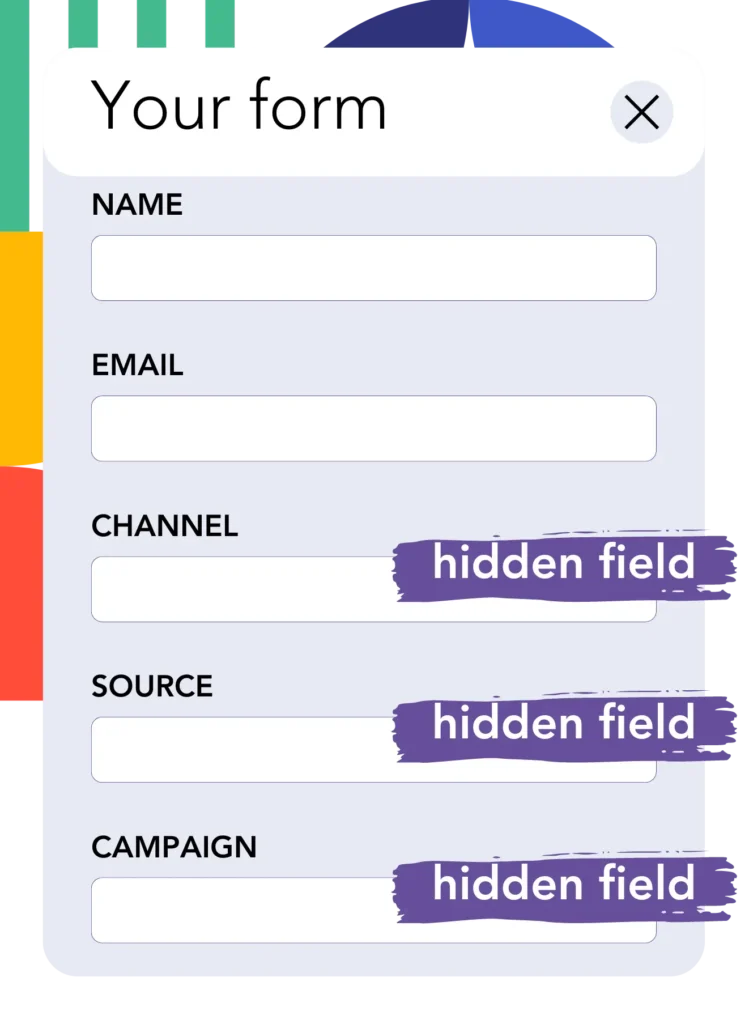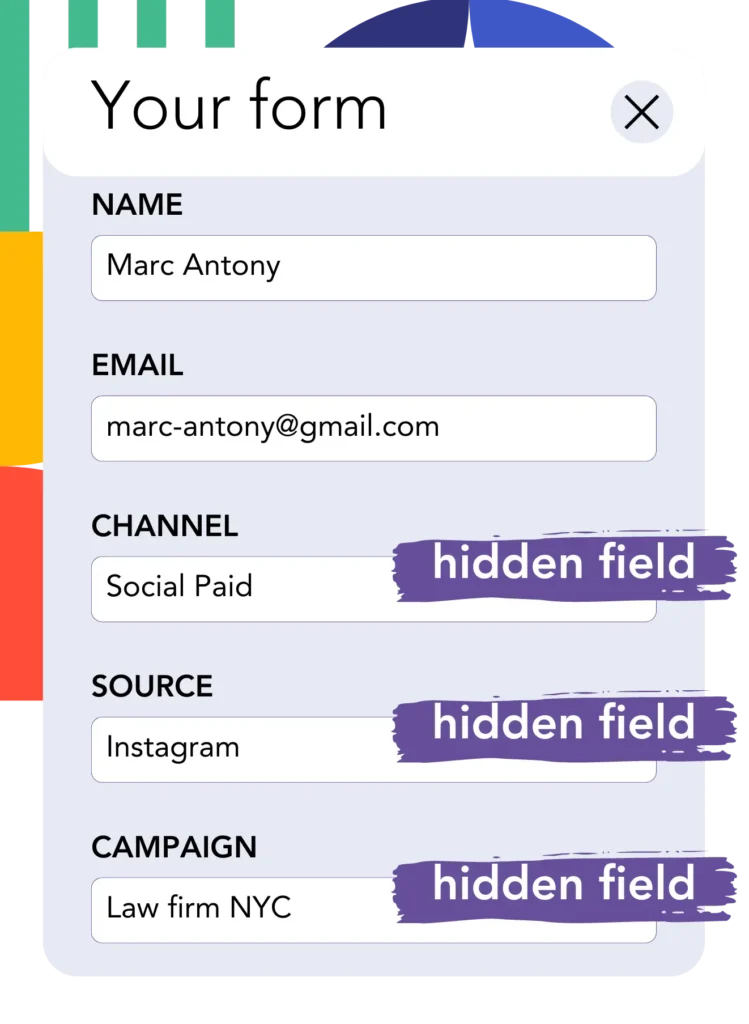Adding UTM tracking to Clearbit Forms can be challenging, especially for those without coding skills.
What if there was a solution to easily capture UTM parameters into Clearbit Forms, without using any code?
Discover Leadsources.io!
Leadsources is a lead source tracking tool that acts as a middleman between your UTM parameters and Clearbit Forms.

When a visitor clicks on your marketing campaign, Leadsources captures the UTM parameters contained in your URL.
Leadsources automatically inserts the UTM parameters in the hidden fields of your Clearbit Forms.
Your UTM parameters can appear next to the lead’s information on the leads submission page in Clearbit Forms.
In just 10 minutes, this guide will show you how to set up UTM tracking in Clearbit using Leadsources, no coding skills required.
Implement Clearbit Forms UTM tracking in 4 easy steps:
Step 1: Add Leadsources in the head tag of your website

Sign up to Leadsources.io and benefit from our 14-day free trial.
Add the Leadsources code into the head tag of your website. No coding and no developers are required.
Simply follow the step-by-step guides we have created.
Step 2: Add the UTM parameters to your campaigns

Add the UTM parameters you want to track in all your campaigns (PPC, email, social media, etc.).
Leadsources works with any of the following UTM parameters:
- UTM_source
- UTM_campaign
- UTM_term
- UTM_content
Leadsources also captures information not contained in UTM parameters, such as the channel, landing page, and landing page subfolder.
Step 3: Add the hidden fields to your Clearbit Forms

When your visitors fill out your Clearbit Forms, they add personal data in the visible fields (name, email, etc.).
In parallel, Leadsources.io automatically inserts the UTM parameters into the hidden fields of your Clearbit Forms (channel, source, etc.).
To do so, add the hidden fields on Clearbit Forms that will store your UTM parameters.
Add Hidden Fields:
- Within the Logic section, click on “personalize with data”.
- Click on “hidden fields”.
Add the exact following fields one by one:
- channel
- source
- campaign
- term
- content
- landingpage
- landingpagesubfolder
Step 4: Track the UTM parameters in Clearbit Forms

When someone clicks on your campaign and lands on your website, Leadsources captures the UTM parameters contained in your URL.
The visitor opens your Clearbit Form and starts filling it out.
Leadsources inserts the UTM parameters in the hidden fields of your Clearbit Forms. These fields are not visible to the visitor.
Upon the submission of the form, the UTM parameters and the form’s responses are submitted together. You can find all this information on the submission page on Clearbit Forms.
How does Leadsources work?
By adding the Leadsources code in the head tag of your website, Leadsources reads and captures the UTM parameters contained in your URL every time someone lands on your site.
It then stores the UTM parameters in the hidden fields of your Clearbit Forms.
If a visitor enters your site without clicking on a link containing UTM parameters, Leadsources still reads and captures data about the visitor using the referrer:
- Channel
- Source
- Campaign
- Landing page
- Landing page subfolder
As a result, you can track important lead source data, even when you can’t (or don’t want to) use UTM parameters, like:
- On Google Search
- On your Instagram bio link
- On your social media posts
While most tools can only track the source of your leads by using UTM parameters only, Leadsources allows you to track the source of your leads regardless of where they are coming from, UTM parameters or not:
- Organic Search
- Paid Search
- Organic Social
- Paid Social
- Referral
- Affiliate
- Display Advertising
- Direct Traffic
This enables you to aggregate lead source data in one place.
How to run performance reports
Now that you have captured your lead source data in the hidden fields of your Clearbit Forms, you can use it to run performance reports such as:
- Leads per channel
- Revenue per channel
- Revenue per keyword
This allows you to make educated decisions on your marketing spending.
Let’s look at the various types of reports you can run and their features.
Lead performance reports
You can run reports that show the volume of leads generated by:
- Channel
- Source
- Campaign
- Landing page
- Landing page subfolder
Example #1
You run campaigns on different channels (SEO, PPC, emailing, etc.). You can export the data collected and create the report: “Leads by channel”.

Example #2
Once you know the channel with the highest lead generation (e.g., Google Ads), you can separate this channel to assess the lead count for each ad campaign.

Example #3
Once you know which campaign generates the most leads, you can zoom in on this campaign to investigate the keywords that are responsible for the leads.

Sales performance report
Now that you know which ads and keywords are most effective for lead generation, you should evaluate whether they are contributing to your revenue.
By integrating Clearbit with a CRM like GoHighLevel, you can produce sales reports to see the real impact.
Imagine the following example:
| Channels | Search Paid | Social Paid |
| Leads | 50 | 75 |
| Sales | 5 | 6 |
| Average order value | $150 | $100 |
| Revenue | $750 | $600 |
You ran ads on Google and Facebook, and you saw from the “Leads by Channel” report that Social Paid ads were more effective at generating leads than Search Paid ads.
However, upon reviewing which leads converted into customers, you realized that Search Paid ads were actually more profitable and decide to increase the budget for that channel.
